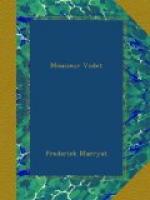It is remarkable to observe, how generally traditions and records will spread and be transmitted among nations destitute of the benefits of the art of printing. In Europe, the mass were certainly better acquainted with their ancient history before this great discovery that they are in our days, as traditions were then handed down from family to family—it was a duty, a sacred one, for a father to transmit them to his son, unadulterated, such, in fact, as he had received them from his ancestors. It is the same case with the Indians, who have remained stationary for a long period. It is in the long evenings of February, during the hunting seasons that the elders of the tribe will reveal to the young warriors all the records of their history; and were a learned European to assist at one of these “lectures upon antiquity,” he would admit that, in harmony, eloquence, strength of argument, and deduction, the red-coloured orator could not easily be surpassed.
The Shoshones have a clear and lucid recollection of the far countries whence they have emigrated. They do not allude to any particular period, but they must have been among the first comers, for they relate with great topographical accuracy all the bloody struggles they had to sustain against newer emigrants. Often beaten, they were never conquered, and have always occupied the ground which they had selected from the beginning.
Unlike the great families of the Dahcotahs and Algonquins, who yet retain the predominant characteristics of the wandering nations of South-west Asia, the Shoshones seem to have been in all ages a nation warlike, though stationary. It is evident that they never were a wealthy people, nor possessed any great knowledge of the arts and sciences. Their records of a former country speak of rich mountainous districts, with balmy breezes, and trees covered with sweet and beautiful fruits; but when they mention large cities, palaces, temples, and gardens, it is always in reference to other nations, with whom they were constantly at war; and these traditions would induce us to believe that they are descendants of the Mancheoux Tartars.
They have in their territory on both sides of the Buona Ventura river many magnificent remains of devastated cities; but although connected with a former period of their history, they were not erected by the Shoshones.
The fountains, aqueducts, the heavy domes, and the long graceful obelisks, rising at the feet of massive pyramids, show indubitably the long presence of a highly civilized people; and the Shoshones’ accounts of these mysterious relics may serve to philosophers as a key to the remarkable facts of thousands of similar ruins found everywhere upon the continent of America. The following is a description of events at a very remote period, which was related by an old Shoshone sage, in their evening encampment in the prairies, during the hunting season:—




